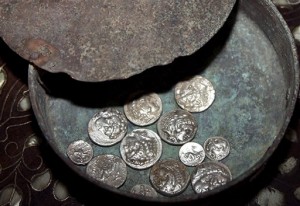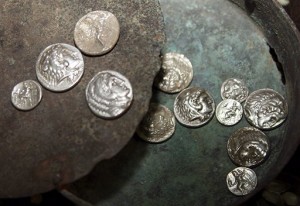A man digging the foundation of his new home in northern Syria uncovered a cache of over 250 coins from the Hellenistic era (4th to 1st centuries B.C.).
He gave the coins in their bronze box to the authorities, and they’re now being analyzed and cataloged.
[Youssef Kanjo, the head of archaeological excavations in the ancient city of Aleppo,] added that the box contained two groups of coins, 137 “tetra” drachmas (four drachmas) and 115 single drachma coins.
One side of the tetra drachma coins depicts Alexander the Great, while the other side shows the Greek god Zeus sitting on a throne with an eagle perched on his extended arm.
Some of the coins bear the inscription King Alexander in Greek, while others say Alexander or carry the name of King Philip, most likely referring to his father.
Alexander conquered Syria in 333 B.C., after his defeat of Darius III of Persia at the Battle of Issus. It and the rest of Alexander’s Asian empire became the Seleucid Empire after Alexander’s death and the splintering of his generals.
Alexander coins would have kept being produced under the Seleucid Empire, which would was finally toppled by Tigranes of Armenia 20 years or so before Pompey yoinked Syria for good for Rome in 64 B.C.

